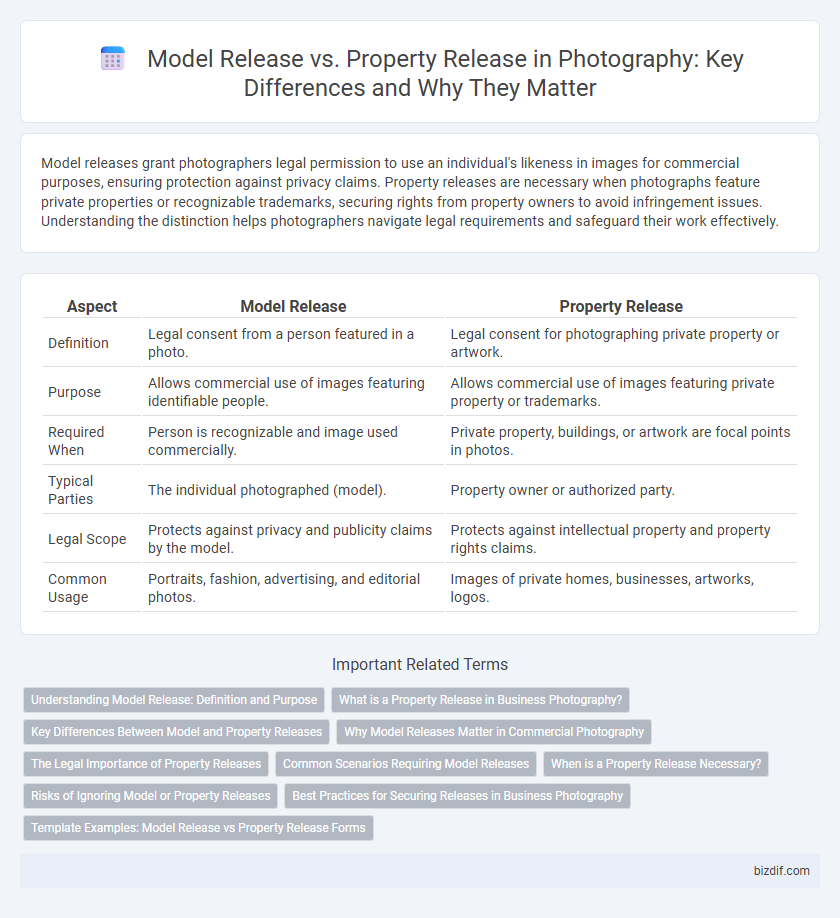Model releases grant photographers legal permission to use an individual's likeness in images for commercial purposes, ensuring protection against privacy claims. Property releases are necessary when photographs feature private properties or recognizable trademarks, securing rights from property owners to avoid infringement issues. Understanding the distinction helps photographers navigate legal requirements and safeguard their work effectively.
Table of Comparison
| Aspect | Model Release | Property Release |
|---|---|---|
| Definition | Legal consent from a person featured in a photo. | Legal consent for photographing private property or artwork. |
| Purpose | Allows commercial use of images featuring identifiable people. | Allows commercial use of images featuring private property or trademarks. |
| Required When | Person is recognizable and image used commercially. | Private property, buildings, or artwork are focal points in photos. |
| Typical Parties | The individual photographed (model). | Property owner or authorized party. |
| Legal Scope | Protects against privacy and publicity claims by the model. | Protects against intellectual property and property rights claims. |
| Common Usage | Portraits, fashion, advertising, and editorial photos. | Images of private homes, businesses, artworks, logos. |
Understanding Model Release: Definition and Purpose
A model release is a legal document granting permission from the subject in a photograph to use their likeness for commercial purposes, ensuring the photographer's right to publish and sell the images. It protects both the photographer and the model by clearly defining usage rights and preventing potential legal disputes over privacy or unauthorized use. Unlike a property release, which concerns permission to use private property in images, a model release specifically addresses individual consent and image rights.
What is a Property Release in Business Photography?
A property release in business photography is a legal document granting permission to use images of private property, such as buildings, artwork, or branded products, for commercial purposes. This release protects photographers and clients from potential legal claims related to the property's likeness, ensuring the right to reproduce and distribute the images without restrictions. Securing a property release is essential when photos feature recognizable private locations or trademarked items that could affect intellectual property rights.
Key Differences Between Model and Property Releases
Model releases grant permission to use an individual's likeness for commercial purposes, protecting photographers from legal claims related to privacy or publicity rights. Property releases, on the other hand, are required when photographing private property or recognizable trademarked elements, ensuring the property owner's consent for commercial use. Key differences include the subject covered--people versus property--and the legal protections each release provides in commercial photography.
Why Model Releases Matter in Commercial Photography
Model releases are essential in commercial photography to secure legal permission from individuals depicted in images, ensuring rights to use their likeness for advertising or promotional purposes. Without a signed model release, photographers risk legal disputes over privacy and unauthorized image use, which can halt distribution and sales. This legal protection not only safeguards the photographer but also builds trust with clients, enabling smoother transactions and wider use of photographic content in commercial markets.
The Legal Importance of Property Releases
Property releases are legally essential documents that grant photographers permission to use images of private properties, ensuring protection against potential lawsuits related to property rights. Unlike model releases, which cover personal likenesses, property releases focus on securing the owner's consent for commercial or editorial uses of buildings, artwork, or trademarks visible in the photos. Obtaining a property release mitigates legal risks and preserves the commercial value of images featuring private locations or distinctive architectural elements.
Common Scenarios Requiring Model Releases
Common scenarios requiring model releases include professional photo shoots where identifiable individuals appear prominently, such as portrait sessions, fashion photography, or advertising campaigns. Images used for commercial purposes, including promotional materials, product packaging, or social media marketing, often mandate signed model releases to protect legal rights. Events with crowds or public figures also typically require releases to ensure consent for image usage beyond editorial contexts.
When is a Property Release Necessary?
A Property Release is necessary when photographing privately owned real estate, artwork, or trademarks where the owner's consent is required for commercial use. Images featuring distinctive architectural designs, branded products, or interior details intended for marketing or advertising purposes typically need this legal permission. Without a Property Release, using these photos commercially can lead to copyright or trademark infringement claims.
Risks of Ignoring Model or Property Releases
Ignoring model releases can lead to legal disputes over the unauthorized use of a person's likeness, resulting in costly damages and restrictions on commercial use. Skipping property releases exposes photographers to infringement claims from property owners, especially when private or trademarked locations are featured. Both oversights risk financial loss and damage to reputation, underscoring the importance of obtaining proper releases for professional photography.
Best Practices for Securing Releases in Business Photography
Securing both model releases and property releases is essential in business photography to avoid legal disputes and ensure smooth usage rights. Best practices include clearly explaining the scope of usage to clients and subjects, obtaining signed releases before the shoot, and keeping organized digital copies for easy access. Utilizing standardized release forms tailored to specific jurisdictions helps maintain compliance and protects the photographer's intellectual property.
Template Examples: Model Release vs Property Release Forms
Model release forms grant permission from individuals photographed to use their likeness commercially, essential for portraits and personal images; property release forms secure rights to use private property or trademarked elements captured in photos, crucial for architectural or commercial shoots. Templates for model releases typically include detailed personal information, consent clauses, and usage rights, while property release templates emphasize ownership details, location permissions, and conditions for commercialization. Choosing accurate release forms ensures legal protection and clarity for photographers, clients, and subjects in all visual content usage.
Model Release vs Property Release Infographic

 bizdif.com
bizdif.com